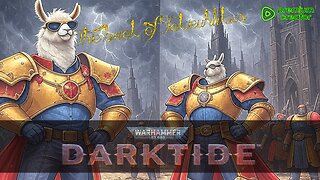Premium Only Content

Episode 1216: St Brendan
St Brendan the Navigator
"Saint Brendan" redirects here. For the contemporaneous Irish saint Brendan of Birr, see Brendan of Birr. For other uses, see St. Brendan's (disambiguation).
Saint Brendan the Navigator
"Saint Brendan and the Whale" Catholic priest, abbot
Born c. AD 484
Ciarraighe Luachra near Tralee, Kingdom of Munster
Died c. AD 577
Feast 16 May
priest celebrating Mass on board a ship while fish gather to listen; one of a group of monks in a small boat
Patronage: boatmen; divers; mariners; sailors; travellers; whales; portaging canoes; Diocese of Clonfert; Diocese of Kerry
Brendan of Clonfert (c. AD 484 – c. 577) is one of the early Irish monastic saints and one of the Twelve Apostles of Ireland. He is also referred to as Brendan the Navigator, Brendan the Voyager, Brendan the Anchorite, Brendan the Bold. The Irish translation of his name is Naomh Bréanainn or Naomh Breandán. He is mainly known for his legendary voyage to find the “Isle of the Blessed” which is sometimes referred to as “Saint Brendan’s Island”. The written narrative of his journey comes from the immram The Navigatio Sancti Brendani Abbatis (Voyage of Saint Brendan the Abbot).
The earliest mention of Brendan is in the Vita Sancti Columbae (Life of Saint Columba) of Adamnan written between AD 679 and 704. The earliest mention of him as a seafarer appears in the Martyrology of Tallaght of the ninth century.
The principal works regarding Brendan and his legend are a "Life of Brendan" in several Latin (Vita Brendani) and Irish versions (Betha Brenainn) and the better known Navigatio Sancti Brendani Abbatis (Voyage of Saint Brendan the Abbot).Unfortunately, the versions of the Vita and the Navigatio provide little reliable information of his life and travels; they do, however, attest to the development of devotion to him in the centuries after his death. An additional problem is that the precise relationship between the Vita and the Navigatio traditions is uncertain.
The date when the Vita tradition began is uncertain. The earliest surviving copies are no earlier than the end of the twelfth century, but scholars suggest that a version of the Vita was composed before AD 1000. The Navigatio was probably written earlier than the Vita, perhaps in the second half of the eighth century. Aengus the Culdee, in his Litany, composed in the end of the eighth century, invoked "the sixty who accompanied St. Brendan in his quest for the Land of Promise".
Any attempt to reconstruct the facts of the life of Brendan or to understand the nature of his legend must be based principally on Irish annals and genealogies and on the various versions of the Vita Brendani.
Early life
Brendan was born in AD 484 in Tralee, in County Kerry, in the province of Munster, in the south-west of Ireland.
He was born among the Altraige, an Irish clan originally centred around Tralee Bay, to parents called Finnlug and Cara. Tradition has it that he was born in the Kilfenora/Fenit area on the North side of the bay. He was baptised at Tubrid, near Ardfert by Erc of Slane,[6] and was originally to be called "Mobhí" but signs and portents attending his birth and baptism led to him being christened 'Broen-finn' or 'fair-drop'. For five years he was both educated and given in fosterage to St. Íte of Killeedy, "The Brigid of Munster". When he was six he was sent to Jarlath's monastery school at Tuam to further his education. Brendan is considered one of the "Twelve Apostles of Ireland", one of those said to have been tutored by the great teacher, Finnian of Clonard.
Foundations
At age 26, Brendan was ordained a priest by Erc. Afterward, he founded a number of monasteries. Brendan's first voyage took him to the Aran Islands, where he founded a monastery. He also visited Hinba (Argyll), an island off the Scottish coast, where he is said to have met Columcille. On the same voyage he travelled to Wales and finally to Brittany, on the northern coast of France.
Between AD 512 and 530 Brendan built monastic cells at Ardfert, and Shanakeel (Seana Cill, usually translated as the "Old Church"), at the foot of Mount Brandon. From there he is supposed to have embarked on his famous voyage of 7 years for Paradise. The old Irish calendars assigned a feast for the "egressio familiae Sancti Brendani".
Legendary journey
Brendan is primarily renowned for his legendary journey to the Isle of the Blessed as described in the Navigatio Sancti Brendani Abbatis (Voyage of Saint Brendan the Abbot) of the ninth century. Many versions exist that narrate how he set out on the Atlantic Ocean with sixteen monks (although other versions record fourteen monks and three unbelievers who joined in the last minute) to search for the Garden of Eden. One of these companions is said to have been Malo.[9] The voyage is dated to AD 512–530, before his travel to the island of Great Britain. On his trip, Brendan is supposed to have seen Saint Brendan's Island, a blessed island covered with vegetation. He also encountered a sea monster, an adventure he shared with his contemporary Columcille. The most commonly illustrated adventure is his landing on an island which turned out to be a giant sea monster named "Jasconius".
The Voyage of Saint Brendan the Abbot
The earliest extant version of the Navigatio Sancti Brendani Abbatis (Voyage of Saint Brendan the Abbot) was recorded c. AD 900. There are over 100 manuscripts of the narrative throughout Europe and many translations. The Navigatio is plainly a Christian narrative, but also narrates natural phenomena and fantastical events and places, which appealed to a broad audience. The Navigatio contains many parallels and inter-textual references to Bran and The Voyage of Máel Dúin.
On the Kerry coast, Brendan built a currach-like boat of wattle, covered it with hides tanned in oak bark and softened with butter, and set up a mast and a sail. He and a small group of monks fasted for 40 days, and after a prayer on the shore, embarked in the name of the Most Holy Trinity.[10] The narrative is characterized by much literary licence, e. g., it refers to Hell where "great demons threw down lumps of fiery slag from an island with rivers of gold fire" and also to "great crystal pillars". Many speculate that these are references to volcanic activity around Iceland and to icebergs.
The journey of Brendan first begins when he meets with Saint Barinthus. Saint Barinthus describes The Promised Land for Saints (Terra Repromissionis Sanctorum). As Saint Barinthus describes his journey to this island, Brendan decides to also visit this island because it was described as a place of those who lived a certain lifestyle and embraced true faith of Christianity. Brendan assembles a group of 14 monks who pray together with him in his community to leave with him on his journey. Before departing, Brendan and the 14 monks fast at 3 day intervals for 40 nights and set out out on the voyage that was described to him by Saint Barinthus. They first embark towards Saint Edna, which is an island. After Brendan and the 14 monks build a small boat for their journey, 3 people join after Brendan already choose his companions. These three extras will not return to Ireland which is prophesied by Brendan because according to him, this is now an unholy number.
For a period of seven years, Brendan and his students travel the seas and come across various locations while searching for the Promised Land. One of the first islands that Brendan and his companions come across is an unnamed uninhabited island. It is on this island that the first of the three extra monks who accompanied Brendan on his travels dies. After the death of their companion, Brendan and his men leave and continue their journey to the Island of Sheep. After a short stay on the Island of Sheep, Brendan and his crew land on the back of a giant fish named Jasconius, which they believe to be an island. But once they light a fire, the island starts to move revealing its true nature. Other places that Brendan and his companions arrive at include the Island of Birds, the Island of Ailbe inhabited by a community of silent monks, and the Island of Strong Men. In some accounts, it is on the Island of Strong Men where the second of the 3 extra people remains instead of continuing his journey with Brendan and his men. The third is dragged away by demons.
After travelling for seven years, visiting some of the same places over and over again, they finally arrive in the Promised Land for Saints. They are welcomed and allowed to enter briefly. Awed by what they have seen, they return to Ireland rejoicing.
Tale of reaching North America
Belief in the existence of Saint Brendan's Island was almost completely abandoned until a new theory arose that the Irish were the first Europeans to encounter the Americas.
There is no reliable evidence to indicate that Brendan ever reached Greenland or the Americas. The Saint Brendan Society celebrates the belief that Brendan was the first European to reach North America. Tim Severin demonstrated that it is possible for a leather-clad boat such as the one described in the Navigatio to reach North America.Severin's film The Brendan Voyage of 1978, which documented his team's feat, inspired the Irish composer Shaun Davey to write his orchestral suite "The Brendan Voyage".
The Navigatio was known widely in Europe throughout the Middle Ages. Maps of Christopher Columbus’ time often included an island denominated Saint Brendan's Isle that was placed in the western Atlantic Ocean. Paul Chapman argues that Christopher Columbus learned from the Navigatio that the currents and winds would favor westbound travel by a southerly route from the Canary Islands, and eastbound on the return trip by a more northerly route, and hence followed this itinerary on all of his voyages.
Later life
Brendan travelled to Wales and the holy island of Iona, off the west coast of Scotland; returning to Ireland, he founded a monastery in Annaghdown, where he spent the rest of his life. He also founded a convent at Annaghdown for his sister Briga. Having established the bishopric of Ardfert, Brendan proceeded to Thomond, and founded a monastery at Inis-da-druim (currently Coney Island), in the present parish of Killadysert, County Clare, c. AD 550. He then journeyed to Wales and studied under Gildas at Llancarfan, and thence to Iona, for he is said to have left traces of his apostolic zeal at Kil-brandon (near Oban) and Kil-brennan Sound. After a mission of three years in Britain he returned to Ireland, and evangelized further in various parts of Leinster, especially at Dysart, County Kilkenny, Killeney near Durrow (Tubberboe Irish: Tóbar Bó, meaning 'Well of the cow'), and Brandon Hill. He established churches at Inchiquin, County Galway, and Inishglora, County Mayo, and founded Clonfert in Galway c. AD 557. He died c. AD 577 in Annaghdown, while visiting his sister Briga. Fearing that after his death his devotees might take his remains as relics, Brendan had previously arranged to have his body secretly returned to the monastery he founded in Clonfert, concealed in a luggage cart. He was interred in Clonfert Cathedral.
-

SpartakusLIVE
7 hours ago#1 Rocket CHAMPION of Verdansk wields UNSTOPPABLE new META
71.6K5 -
 2:55:11
2:55:11
Barry Cunningham
7 hours agoPRESIDENT TRUMP MADE TODAY A VERY BAD DAY TO BE A DEMOCRAT!
86.8K54 -
 1:15:29
1:15:29
Flyover Conservatives
1 day agoFrom Cool to Cringe: How Democrats Lost America’s Ear | FOC Show
38.5K13 -
 8:19
8:19
MattMorseTV
10 hours ago $4.41 earnedTrump is ACTUALLY DOING IT.
36.5K37 -
 11:30:43
11:30:43
ZWOGs
13 hours ago🔴LIVE IN 1440p! - Tarkov w/ Casey & crgoodw1n, Kingdom Come Deliverance, & More - Come Hang Out!
32.2K5 -
 2:30:56
2:30:56
We Like Shooting
17 hours ago $1.77 earnedWe Like Shooting 625 (Gun Podcast)
28K1 -
 1:45:02
1:45:02
Glenn Greenwald
8 hours agoIsrael Slaughters More Journalists, Hiding War Crimes; Trump's Unconstitutional Flag Burning Ban; Glenn Takes Your Questions | SYSTEM UPDATE #504
132K172 -
 1:29:31
1:29:31
Killerperk
4 hours ago $0.74 earnedRoad to BF6. Come hang out #regiment #bf6
30.2K2 -
 4:35:45
4:35:45
Jokeuhl Gaming and Chat
5 hours agoDARKTIDE - Warhammer 40k w/ Nubes Bloobs and AoA
20.9K2 -
 LIVE
LIVE
Cripiechuccles
6 hours ago😁💚💙MOTA MONDAY WITH CRIPIE💚💙 👌SMOKING, GAMING & WATCHING FLICKS!:😁
40 watching